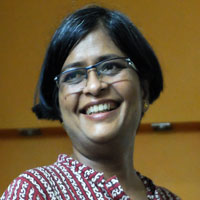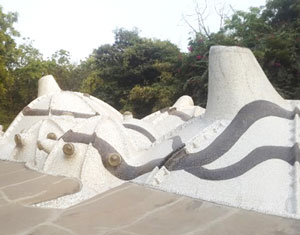Smita Dalvi
 Who speaks for Indian architecture? Who are the influential voices that drive the discourse on practice in the millennium? There are several potential ‘mouth-pieces’ – from professional and semi-professional bodies, popular glossy magazines, a few scattered journals, conferences, symposia, even blogs. But how effective are these in articulating positions in architecture specific to our country and region? There has largely been a benign, almost patronising attitude toward architectural production, especially within the profession itself. For the most, the visual overwhelms actual content, while deeply researched, well analysed arguments are few and far between. This was not always the case. When the first generation of Indian architectural practices established themselves in British India, their voices were both critical and affirmative. Voices we miss today.
Who speaks for Indian architecture? Who are the influential voices that drive the discourse on practice in the millennium? There are several potential ‘mouth-pieces’ – from professional and semi-professional bodies, popular glossy magazines, a few scattered journals, conferences, symposia, even blogs. But how effective are these in articulating positions in architecture specific to our country and region? There has largely been a benign, almost patronising attitude toward architectural production, especially within the profession itself. For the most, the visual overwhelms actual content, while deeply researched, well analysed arguments are few and far between. This was not always the case. When the first generation of Indian architectural practices established themselves in British India, their voices were both critical and affirmative. Voices we miss today.
Mustansir Dalvi, in his paper on emergence of modernist sensibilities in Bombay in the thirties and the forties weaves together a narrative of the two formative decades by deciphering voices chronicled in the pages of the Journal of the Indian Institute of Architects (JIIA) and other contemporary publications. Most interesting are the many concerns and challenges articulated in the addresses of the then presidents of the IIA – Lovji Shroff, Burjor Agha and Claude Batley, amongst others. Looking back, it is evident that there was a simultaneous reflection on the ongoing trends in architectural design and that the professional body led the debates around them. Over the time we have witnessed an erosion of this practice making our profession somewhat lacking a robust voice.
Even as professional bodies have receded from leading the debate on Indian architecture, we have seen a spurt of individual and collective initiatives articulating alternate voices through a mode of exhibition. There have been quite a few notable ones in last three years. Two ambitious exhibitions in Mumbai, namely ‘The State of Architecture: Practices and Processes in India’ and ‘The State of Housing in India’, curated by Rahul Mehrotra, Kaiwan Mehta and Ranjit Hoskote comprehensively looked at the trajectories of the profession in the seven decades after independence. Both were also supplemented by several collateral mini exhibitions put up by individuals and institutions in Mumbai. ‘Delhi: Building the Modern’, put up by Ram Rahman vividly portrayed the emergence of modernist architecture in the post-colonial nation. In Jaipur, the Jawahar Kala Kendra hosted an exhibition titled, ‘When is Space?’ curated by Rupali Gupte and Prasad Shetty that looked at the contemporary architecture and space making practices in India. There was the provocatively titled ‘Death of Architecture: Circa 2000’ – an experimental multi-media exhibition put up by a collective of thirteen architectural practices from across the country.
These exhibitions centred around modes of practice or its historiography. They were diverse in scope and magnitude and experimented with form of the exhibits and nature of provocations. They represented a diversity of voices emanating from the profession and academia and a certain robustness of will to engage with issues in the practice of architecture. We certainly need more of these provocations not less. Their attendant productions such as catalogues and conference proceedings form today’s voices that will bear on the future.
Among many provocations posed by the State of Architecture exhibition in 2016, one went thus, “Why aren’t there more practising women architects?”
Two recent books on women architects in India by Madhavi Desai and Mary N. Woods bring to the fore lesser known or unknown stories of female participation in the shaping of the Indian Modern. Nancy Adajania, while annotating these publications in her essay in this issue says the books contextualise the lifework of “those who have been invisibilised for far too long”. What are the reasons for this invisibility or absence from the discourse? I believe, many women like Perin Mistry who worked with fathers or husbands have gone unrecorded as the firms were/ are named after either the family or the male partner. Even today, while the number of women graduates is on par and more of them joining the workforce, the profession and the leadership roles are dominated by men. What Adajania calls as entrenched asymmetries in a patriarchy is actually a mindset that relegates the roles of women as subordinate to male partners or colleagues. This is a universal malaise, not just of this country. The emerging research here and elsewhere is bringing to light the voices unheard or supressed. On the other hand, the feisty new generation of women are now crafting their independent voices in their multimodal practices.
The question of voice is also pertinent in pedagogy. The design studio, around which architecture education revolves is also site of production of knowledge. Whose voices are represented in this production? Meghal Arya in her essay has raised this issue of authorship in a design studio.
In this issue, we feature the following papers and essays.
Chandrakanth K. in his paper on ecological impact of urban development examines the case of lakes of Bengaluru by mapping their gradual extinction over a period of time. He argues that in the long run there will be serious consequences if development policies in metropolitan areas ignore ecological resources. Supriya Nene in her essay creates an exhaustive list of wide ranging rating systems or tools in force in countries across the world and then compares their priority areas based on an analysis of a chosen sample. Meghal Arya in her paper on authoring design studios dwells on the modes of knowledge production in the design studio and considering its centrality in architecture education discusses the role of a design teacher. Mustansir Dalvi in his paper, traces the development of a modern urban sensibility in the architecture in Bombay in the decades before the Nation State. This he does by excavating contemporary writings and speeches of the practitioners. Nancy Adajania in her review essay discusses two recent publications on women architects in India. While annotating them she brings in a nuance of feminist criticism of the prevalent modernist architectural discourse urging us to jettison readily recognisable tropes with which to view an architect’s work.
In the Practice section, Ashok B. Lall, a much-respected architect and teacher reflects on the profession of architecture and voices a need to rethink the very value and purpose of creating architecture. He expresses a desire to both expand the scope of nomenclature of architectural design and the ambit of its professional categorization.
For the Dialogue section in this issue, Amita Sinha, Professor of Landscape Architecture from University of Illinois at Urbana Champaign engages Galen Cranz, a sociologist and a long-standing Professor of Architecture at the University of California at Berkeley in a short but insightful interview in which she draws out the latter on the sociality of the built environment – a theme running across her teaching and her books. Amita Sinha also reviews Galen Cranz’s latest book Ethnography for Designers (2016) in this issue. The book according to Sinha, is a welcome guide for design research that values qualities of human experience as it advocates learning to view the built environment from the standpoint of the users in order to appreciate its social and cultural meanings.
Finally, we join the community of architects in celebrating the conferment of Pritzker Prize on Balkrishna Doshi, a doyen of Indian architecture. Doshi’s oeuvre and long career parallels the journey of Indian architecture from late fifties. He apprenticed with Le Corbusier and directly imbibed his values. These are clearly visible in his early buildings but then his work made gradual shifts that underlied a search for an Indian modern. Although his buildings are among the canon of India’s post-independence architecture, his role in founding the CEPT in the sixties – an institution of vision and excellence and his role in mentoring scores of next generation architects is the one which is unparalleled. The intangibles of fostering a culture of design and architecture counts for an equal measure and for this Doshi stands tall.
He is a man of many interests – music, cinema and painting. His collaboration with M.F. Husain, the celebrated artist was the most memorable, resulting in the creation of the delightful space of Amdavad ni Gufa. This gallery invokes a primordial cave and we can see the jugalbandi of master artist and master architect creating forms and spaces that meld poetically. Here it is impossible to separate art from architecture. One hopes that in the wake of this prize, the original name of the gallery – Husain-Doshi Gufa will be restored. The name signified an artistic collaboration, its erasure an obliteration of voices of creative authorship.
Smita Dalvi
smitadalvi@mes.ac.in



